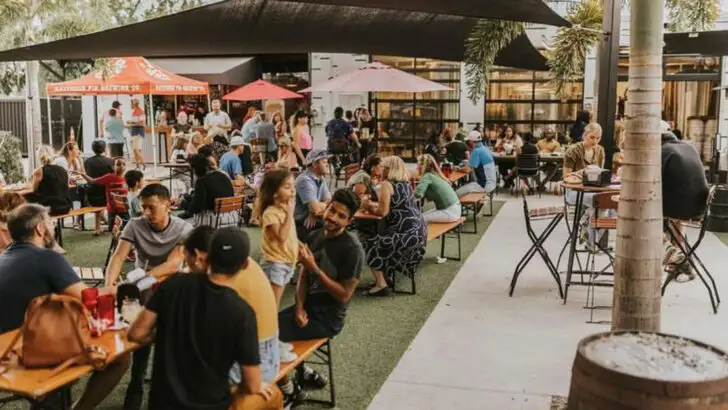Theme park churros can only take you so far. When the heat hits, the lines grow, and you’ve eaten one too many mystery nuggets, it’s time to escape the gates and eat like a real human again. Orlando may be theme park central, but its food scene? Way more impressive than overpriced pretzels. These 11 local spots serve up bold flavors, cozy vibes, and meals that don’t come in souvenir cups. We’re talking crispy chicken sandwiches, artful ramen, dreamy desserts — the kind of food that reminds you what joy actually tastes like. So take a break from the chaos. Step outside the park bubble. And treat yourself to food that’s worth sitting down for.
Edible Herb Beds at Leu Gardens
At the heart of Harry P. Leu Gardens lie edible herb beds, offering more than just visual beauty. Here, visitors can wander through shaded paths and discover seasonal herbs such as basil, oregano, and thyme. These plants are integral to local dishes, providing a fresh twist to classic flavors.
The fragrant scent of herbs fills the air, creating an aromatic experience for all who visit. This garden’s unique setup allows food enthusiasts to learn how these herbs are cultivated and used in Orlando’s culinary scene. It’s a delightful way to connect with both nature and local cuisine.
The Osprey
For seafood lovers, The Osprey offers a dining experience that’s both refreshing and refined. Located in Baldwin Park, this restaurant takes pride in serving the freshest seafood, sourced responsibly and prepared with a modern twist.
With an open kitchen and a menu that changes with the tide, every visit promises something new. The chefs here have a knack for combining traditional techniques with innovative flavors, resulting in dishes that are as surprising as they are satisfying.
Fun fact: The Osprey features an impressive oyster bar with selections that vary daily, offering a true taste of the ocean’s bounty. It’s a haven for seafood enthusiasts looking to indulge in Orlando.
Raised Vegetable Beds at East End Market
East End Market stands as a vibrant community hub, where raised vegetable beds flourish with fresh produce. These beds host herbs and greens like kale, peppers, and mint, which are later used in the market’s kitchens.
This setup gives visitors a visual insight into Orlando’s commitment to local food sustainability. Strolling through the market, one witnesses firsthand the journey of produce from garden to table. The sight of thriving vegetable beds serves as a reminder of the market’s dedication to nourishing its community with homegrown ingredients.
Hydroponic Lettuce at Vertical Farms Near Audubon Park
Near Audubon Park, vertical farms employ cutting-edge hydroponic systems to grow lettuce varieties like romaine and butterhead. These farms redefine urban agriculture with their modern approach to farming.
Visitors are often given a chance to explore these systems up close, observing the neatly arranged rows of greens. It’s a fascinating glimpse into how technology and tradition can blend to produce fresh, sustainable food. The hydroponic lettuce showcases innovation at its finest, offering a model for the future of farming within city limits.
Banana Trees in Backyard Cafés
Several Orlando cafés transform their spaces into tropical retreats by incorporating banana trees into their patios. These trees, with broad leaves, provide shade and a laid-back ambiance.
Diners find themselves enveloped in a subtropical setting, adding a unique flair to their dining experience. The presence of banana trees is not only a nod to Florida’s climate but also an aesthetic choice that enhances the café’s appeal. Patrons enjoy the novelty of dining amidst such exotic surroundings, making each visit memorable.
The Ravenous Pig
The Ravenous Pig isn’t just a restaurant; it’s a local institution. Nestled in Winter Park, this gastropub offers a rotating menu that celebrates Florida’s finest ingredients. With a focus on sustainability, the dishes here are as ethically crafted as they are delicious.
The inviting atmosphere, complete with communal tables and an open kitchen, encourages diners to engage in conversation and forge connections. Each visit offers a new experience, with the chef’s creativity shining through every dish.
Intrigued by its origins? The Ravenous Pig is the brainchild of James and Julie Petrakis, graduates of the Culinary Institute of America. Their passion for great food is evident in every plate.
Rosemary Bushes Outside Artisan Bakeries
Outside some of Orlando’s artisan bakeries, rosemary bushes thrive, filling the air with their savory aroma. These planters or fence line bushes often serve dual purposes—decoration and ingredient.
The rosemary finds its way into various baked goods, from breads and focaccia to infused oils, tantalizing passersby with its scent. This practice not only beautifies the storefront but also connects the bakery’s offerings directly to the local landscape. It’s a delightful fusion of nature and craft that elevates the culinary experience.
Fig Trees Behind Farm-to-Table Restaurants
Nestled behind some of Orlando’s farm-to-table restaurants are fig trees, offering more than just shade. These trees, with their wide leaves, evoke a sense of Mediterranean charm.
Their presence adds to the restaurant’s ambiance, creating an intimate dining atmosphere. The fruit and foliage of fig trees often find their way into the menu, providing a fresh and authentic touch to the dishes. Patrons enjoy the natural setting, a perfect backdrop for savoring thoughtfully prepared meals that celebrate local ingredients.
Butterfly Gardens with Edible Flowers
Orlando’s butterfly gardens burst with color, featuring edible flowers such as nasturtiums and violas. These blooms attract not only pollinators but also curious visitors.
The flowers’ peppery flavors often make appearances in salads and desserts, adding a whimsical touch to local dishes. Wandering through these gardens, one witnesses a harmonious dance of nature, where butterflies and blooms create a lively spectacle. The edible flowers embody a playful element of Orlando’s culinary arts, merging natural beauty with gastronomy.
Bamboo Groves Near Asian-Inspired Eateries
Some of Orlando’s outdoor dining spaces feature bamboo groves, offering a serene escape from the urban hustle. These clumping bamboo varieties form natural privacy screens, adding a gentle rustle to the ambiance.
Diners at Asian-inspired eateries appreciate the tranquil setting, where the bamboo’s presence complements the culinary experience. It’s an artful blend of nature and cuisine, where the setting enhances the flavors on the plate. Visitors find the interplay between environment and dining an enriching aspect of their visit.
Pineapple Plants in Educational Farms and Community Plots
In Orlando’s educational farms, pineapple plants take a starring role. These slow-growing plants, with their spiky leaves, intrigue visitors with their unique appearance.
They provide a fun and educational experience for those interested in tropical fruits. Pineapples grown here often feature in smoothies, salsas, and cocktails, connecting farm to table in a tangible way. The presence of pineapples in community plots showcases Orlando’s dedication to agricultural education and its passion for sharing the joys of homegrown produce.

